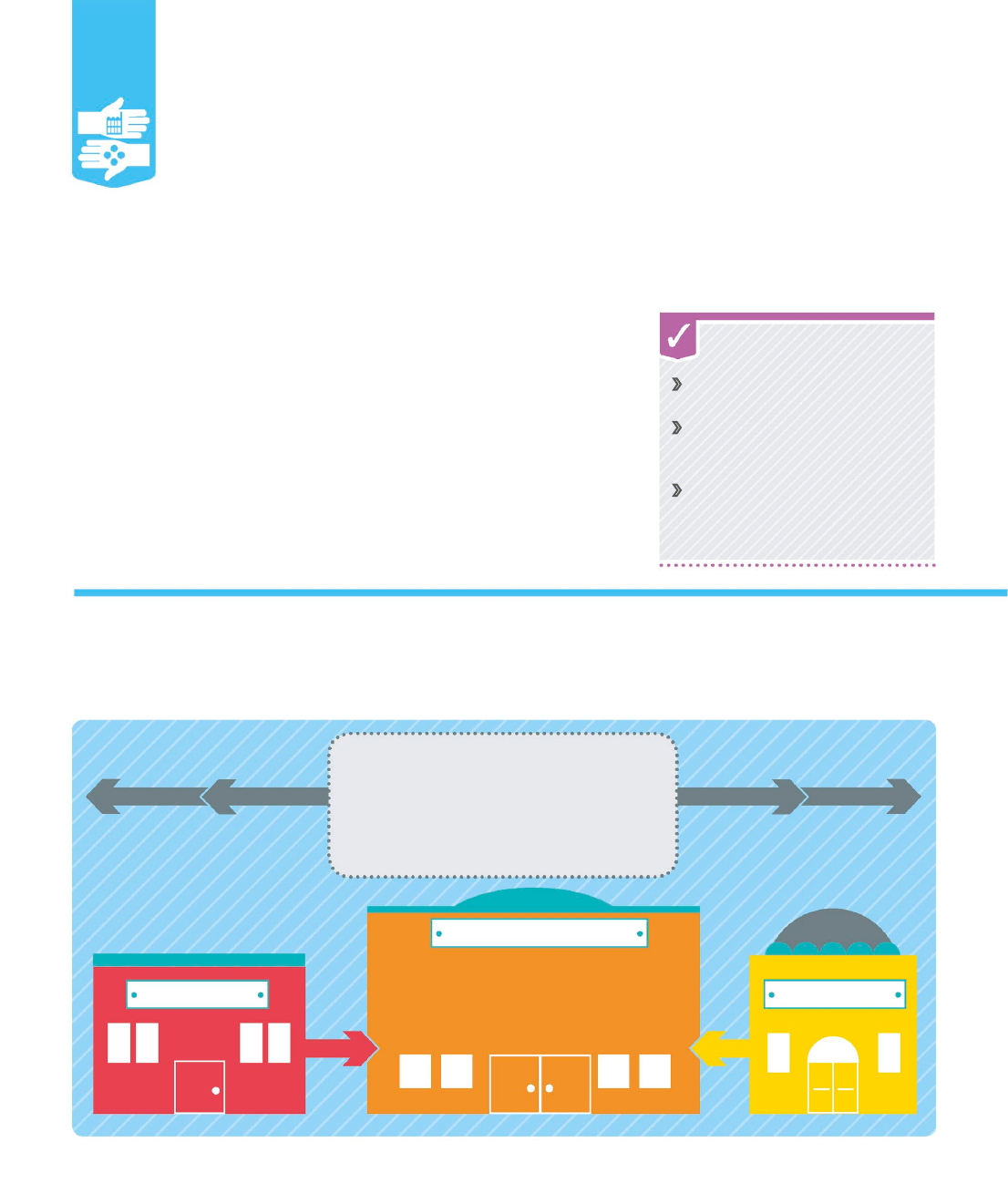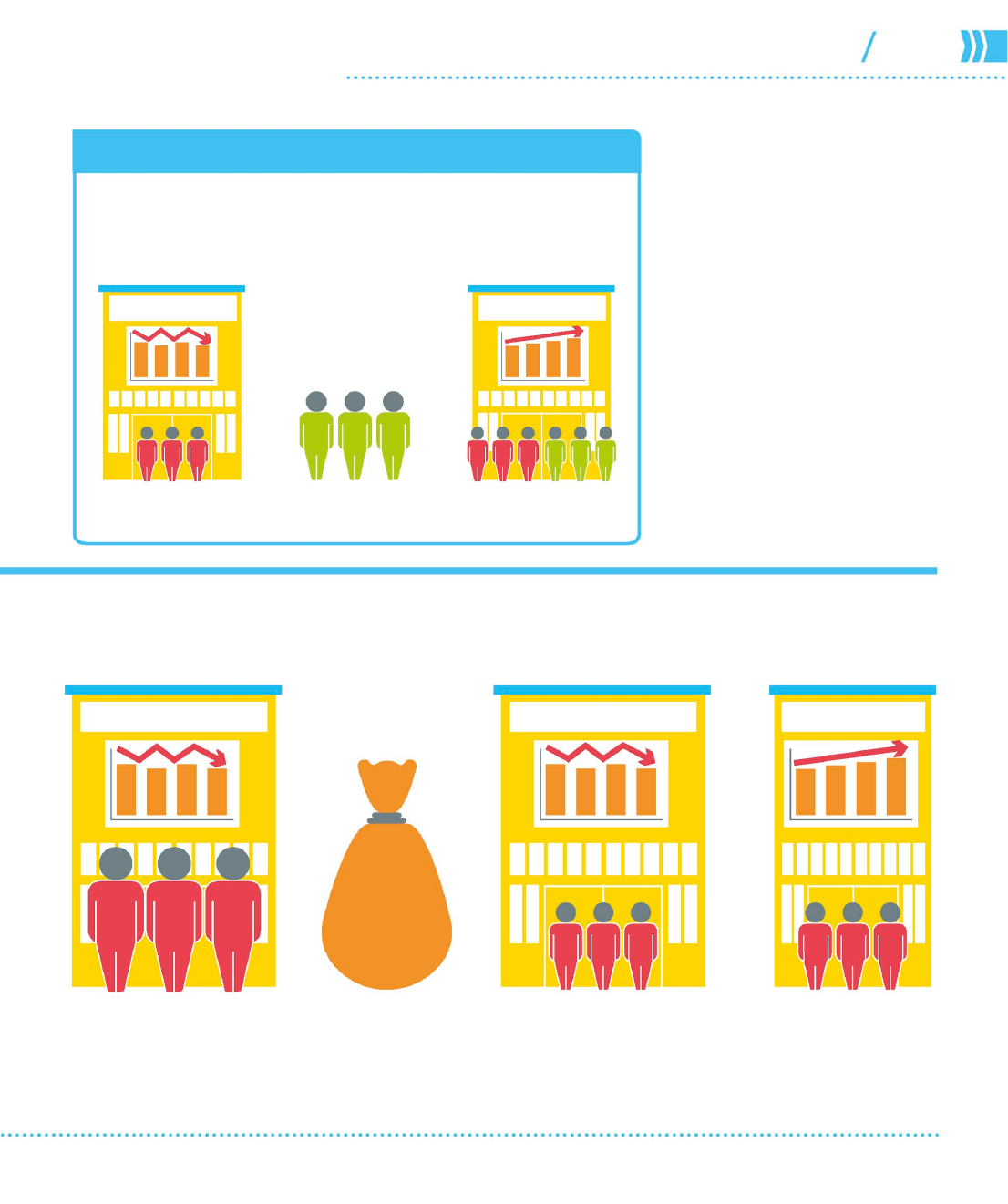
44 45
how companies work
Buying and selling business
52%
the potential
rise in a parent
company’s
share price
following a
divestiture
One company becomes four
The three divisions are sold off to separate
investors and become three separate
companies. Shares for each are sold on the stock
market. The parent company is reduced to its
core business. Its share price rebounds.
The shareholders benefit
Shareholders in the original company also receive the same
percentage holding in shares from the three new companies.
Spin-off New company formed as
the result of a divestiture; also called
a hive-off
Tracking stock Special type
of shares issued by a parent
company for the division or
subsidiary they will sell; tracking
stock is tied to the performance
of the specific division rather than
the company as a whole; also known
as targeted stock
Letter of intent Letter stating
serious intention to do business,
often concerning M and A
Reverse merger Not to be
confused with a divestiture, this
is a quick and cheap method
for a private company to go
public by buying a shell stock—
a public company that is no
longer operating because it went
bankrupt or was simply closed.
Demerger Term commonly used
in the UK for divestiture
NEED TO KNOW
TEXTILESAGRICULTURAL
CHEMICALS
INDUSTRIAL
PAINT
BIOTECHNOLOGY
Smith Industries Inc.
West Inc.
Jones Inc. Brown Inc.
US_044-045_Demergers.indd 45 21/11/2014 14:24

How it works
Companies can choose from several
strategies when they merge or are
part of an acquisition. Two of the
most common are horizontal and
vertical integration.
Horizontal deals are always done
between competitors that produce
similar types of products, such as
cars or mobile phones, and often
share—or compete for—the same
suppliers and clients. As a result of
merger or acquisition, the newly
formed company can make cost
savings in production, distribution,
sales, and marketing. Vertical deals
are usually between businesses
involved in the same industry but
at different stages—for example,
a computer maker and a component
manufacturer. These deals can
be upstream (toward the market)
or downstream (in the direction
of operations and production).
Vertical vs. horizontal
integration
Lateral integration Another
term for horizontal integration
Horizontal monopoly When
a company controls the market
after buying up the competition
Synergy The potential of merged
companies to be more successful
as a single entity
NEED TO KNOW
Companies that want to expand through a merger or acquisition
may decide on a strategy of either horizontal or vertical integration,
combining businesses involved in similar or dissimilar activities.
Publisher A, a general publisher,
acquires specialized academic
Publisher B to strengthen its
textbook division.
PUBLISHER B
PUBLISHER AB
PUBLISHER A
Integration models in practice
In these hypothetical examples, a cluster of printers, publishers, and bookstores
merge or acquire each other in horizontal or vertical deals that aim to strengthen
their market position, take advantage of economies of scale, and exploit synergy.
Horizontal integration
Two publishing companies, both involved
in the process of book creation but with
different areas of specialization, agree to a
merger deal to gain a larger market share.
US_046-047_Vertical_Vs_Horizontal.indd 46 21/11/2014 14:24
46 47
how companies work
Buying and selling business
MERGER AND
ACQUISITION TYPES
31%
of businesses
worldwide
planned to
expand through
a merger or
acquisition in
the three years
from 2014
Conglomerate
Combining two companies with
nothing in common: for example,
in 1985, tobacco-producer Philip
Morris purchased General Foods, a
new line of business unconnected
to legal wrangles around smoking.
Market extension
Combining two companies that sell
the same products but in different
markets: for example, in 1996, the
Union Pacific Railroad Company
acquired the Southern Pacific Rail
Corporation to link railroads in
adjacent US regions.
Product extension
Combining two companies that sell
different but related products in
the same market: for example,
in 2014, Microsoft bought Nokia’s
mobile-phone unit to address
flagging PC sales and its weakness
in the mobile device market.
ONLINE
BOOKSTORE
A
Publisher A buys Printer A
to improve print capacity
and production costs and
provide warehouse space.
PRINTER A
Publisher A buys
Online bookstore A
to improve brand presence
and provide direct sales.
PUBLISHER A
Vertical
integration
A publisher acquires
two related businesses—
a printer and an online
bookstore—so that it can
have greater control over
production of its books
and their route to market.
PUBLISHER/ONLINE
BOOKSTORE A
PUBLISHER/
PRINTER A
Forward
(upstream)
Backward
(downstream)
US_046-047_Vertical_Vs_Horizontal.indd 47 21/11/2014 14:24

46 47
how companies work
Buying and selling business
MERGER AND
ACQUISITION TYPES
31%
of businesses
worldwide
planned to
expand through
a merger or
acquisition in
the three years
from 2014
Conglomerate
Combining two companies with
nothing in common: for example,
in 1985, tobacco-producer Philip
Morris purchased General Foods, a
new line of business unconnected
to legal wrangles around smoking.
Market extension
Combining two companies that sell
the same products but in different
markets: for example, in 1996, the
Union Pacific Railroad Company
acquired the Southern Pacific Rail
Corporation to link railroads in
adjacent US regions.
Product extension
Combining two companies that sell
different but related products in
the same market: for example,
in 2014, Microsoft bought Nokia’s
mobile-phone unit to address
flagging PC sales and its weakness
in the mobile device market.
ONLINE
BOOKSTORE
A
Publisher A buys Printer A
to improve print capacity
and production costs and
provide warehouse space.
PRINTER A
Publisher A buys
Online bookstore A
to improve brand presence
and provide direct sales.
PUBLISHER A
Vertical
integration
A publisher acquires
two related businesses—
a printer and an online
bookstore—so that it can
have greater control over
production of its books
and their route to market.
PUBLISHER/ONLINE
BOOKSTORE A
PUBLISHER/
PRINTER A
Forward
(upstream)
Backward
(downstream)
US_046-047_Vertical_Vs_Horizontal.indd 47 21/11/2014 14:24

How it works
In a management buy-in (MBI),
a group of managers or investors
from outside the company raises
the funds to buy a majority stake
in the company and then takes
over its management. This type
of action occurs when a company
appears to be either undervalued
or underperforming.In a typical
management buy-out (MBO), the
company’s existing management
team purchases all or part of the
company they work for. Despite
the name, MBOs are not restricted
to managers, and they can include
employees from any level of the
organization who wish to make the
transition from employee to owner.
Management buy-ins
and buy-outs
Buy-in
Some companies, such as investment banks or venture capitalists, can make
sizable profits by purchasing undervalued businesses and transforming them.
A company’s ownership may undergo a change, which can be
driven either externally, known as a management buy-in, or
internally, known as a management buy-out.
Earnout A percentage of the
purchase price paid to the sellers
after acquisition if the business
has performed as expected
Leveraged buy-out Acquisition
of a company using equity and
borrowed money, with company
as collateral for loan
need to know
An outside
management team
or investment group
sees that a company
is undervalued.
They raise funds
to buy a majority
shareholding.
They fire and replace the
previous management team.
They overhaul the business
to improve performance and
realize its true value.
Company Company
=
$
–+
US_048-049_Managment_Buy_out_vs_buy_ins_Steve.indd 48 21/11/2014 16:21
48 49
HOW COMPANIES WORK
Buying and selling business
Buy-out
A buy-out allows a large company to sell off a part of the business it no
longer wants or helps a small business owner to retire or move on.
buy-in management buy-out (bimbo)
In this type of transaction, the existing management of a company stages a
buy-out, but additional external management is brought in by financers to
strengthen the company’s leadership and to provide expertise in particular
areas that might be lacking in the original team.
The management team
sees an opportunity to
take ownership when their
corporate division is put
up for sale.
They raise funds via
bank loans, private
investors, their own
capital, or a loan
from the seller.
They buy the business. The management
team—which now
owns the company—
streamlines the
business to make it
more profitable.
Company Company
Company
+
=
=
New management teamOutside management
members brought in
Existing management
members buy company
$22.2
billion
Europe’s biggest
ever leveraged
buy-out—of
chemist chain
Alliance Boots
in 2007
$
Company
+ +
Company
US_048-049_Managment_Buy_out_vs_buy_ins_Steve.indd 49 21/11/2014 16:21

48 49
HOW COMPANIES WORK
Buying and selling business
Buy-out
A buy-out allows a large company to sell off a part of the business it no
longer wants or helps a small business owner to retire or move on.
buy-in management buy-out (bimbo)
In this type of transaction, the existing management of a company stages a
buy-out, but additional external management is brought in by financers to
strengthen the company’s leadership and to provide expertise in particular
areas that might be lacking in the original team.
The management team
sees an opportunity to
take ownership when their
corporate division is put
up for sale.
They raise funds via
bank loans, private
investors, their own
capital, or a loan
from the seller.
They buy the business. The management
team—which now
owns the company—
streamlines the
business to make it
more profitable.
Company Company
Company
+
=
=
New management teamOutside management
members brought in
Existing management
members buy company
$22.2
billion
Europe’s biggest
ever leveraged
buy-out—of
chemist chain
Alliance Boots
in 2007
$
Company
+ +
Company
US_048-049_Managment_Buy_out_vs_buy_ins_Steve.indd 49 21/11/2014 16:21
..................Content has been hidden....................
You can't read the all page of ebook, please click here login for view all page.
